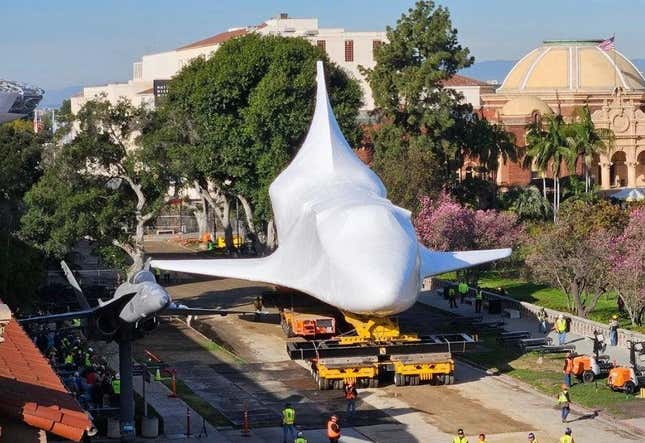NASA’s Space Shuttle Looks Launch Ready for the First Time in Years
NASA’s Endeavour orbiter made its way to the top of a 20-story-tall vertical display of the retired Space Shuttle, completing a legendary ready-for-launch stack that makes it look as though it’s ready to soar to the skies once more.
A 450-foot crane carefully lifted the 122-foot-long (37 meters) winged orbiter onto two solid rocket boosters and a massive external tank for its final vertical position as part of the future Samuel Oschin Air and Space Center, which is currently under construction. The intricate stacking process has never been done outside of a NASA facility before, and marks the first time in more than a decade that the iconic Space Shuttle stood tall as though it was ready for liftoff.
Endeavor has been on display at the California Science Center for the past 11 years, although it was laying on its side rather than being in a go-for-launch position. The orbiter made its way to its new display site on Monday, and the stacking process took place overnight into early Tuesday morning, according to collectSPACE.
The museum’s Go for Stack process began on July 20, 2023, with the aim of building the only “ready for launch” 20-story-tall vertical display of the Space Shuttle. The first part of the process involved installing the rocket’s aft skirts—a pair of skirt-shaped bottom segments that form the base of the solid rocket boosters. In November, the two 116-foot long (35 meters) boosters were then stacked on top to form the base of the display. Earlier this month, External Tank ET-94 was lifted and placed on top of the Solid Rocket Boosters, awaiting the final piece of the puzzle.
NASA’s Space Shuttle Endeavour landed for the final time on June 1, 2011, at the Kennedy Space Center in Florida following a 16-day mission to the International Space Station. Following that landing, only one other Shuttle mission took place, the Atlantis STS-135 mission, marking the end of NASA’s 30-year-long Shuttle era.

The Endeavour orbiter is the crowning jewel of the entire display, serving as the main attraction around which the Air and Space Center building will be constructed.
Since the space is still under construction, a steel plate shell will be built over Endeavour to protect it from falling debris, according to collectSPACE. Construction is expected to continue for another 18 months as the team pulls together around 100 more spacecraft for the Air and Space Center. None of the other displays, however, will require as much time and effort as the Space Shuttle but we think it’s worth it to be able to see the orbiter pointing skywards once again.
For more spaceflight in your life, follow us on X (formerly Twitter) and bookmark Gizmodo’s dedicated Spaceflight page.
NASA’s Endeavour orbiter made its way to the top of a 20-story-tall vertical display of the retired Space Shuttle, completing a legendary ready-for-launch stack that makes it look as though it’s ready to soar to the skies once more.
A 450-foot crane carefully lifted the 122-foot-long (37 meters) winged orbiter onto two solid rocket boosters and a massive external tank for its final vertical position as part of the future Samuel Oschin Air and Space Center, which is currently under construction. The intricate stacking process has never been done outside of a NASA facility before, and marks the first time in more than a decade that the iconic Space Shuttle stood tall as though it was ready for liftoff.
Endeavor has been on display at the California Science Center for the past 11 years, although it was laying on its side rather than being in a go-for-launch position. The orbiter made its way to its new display site on Monday, and the stacking process took place overnight into early Tuesday morning, according to collectSPACE.

The museum’s Go for Stack process began on July 20, 2023, with the aim of building the only “ready for launch” 20-story-tall vertical display of the Space Shuttle. The first part of the process involved installing the rocket’s aft skirts—a pair of skirt-shaped bottom segments that form the base of the solid rocket boosters. In November, the two 116-foot long (35 meters) boosters were then stacked on top to form the base of the display. Earlier this month, External Tank ET-94 was lifted and placed on top of the Solid Rocket Boosters, awaiting the final piece of the puzzle.
NASA’s Space Shuttle Endeavour landed for the final time on June 1, 2011, at the Kennedy Space Center in Florida following a 16-day mission to the International Space Station. Following that landing, only one other Shuttle mission took place, the Atlantis STS-135 mission, marking the end of NASA’s 30-year-long Shuttle era.

The Endeavour orbiter is the crowning jewel of the entire display, serving as the main attraction around which the Air and Space Center building will be constructed.
Since the space is still under construction, a steel plate shell will be built over Endeavour to protect it from falling debris, according to collectSPACE. Construction is expected to continue for another 18 months as the team pulls together around 100 more spacecraft for the Air and Space Center. None of the other displays, however, will require as much time and effort as the Space Shuttle but we think it’s worth it to be able to see the orbiter pointing skywards once again.
For more spaceflight in your life, follow us on X (formerly Twitter) and bookmark Gizmodo’s dedicated Spaceflight page.
